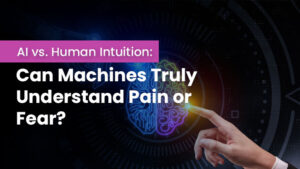
From Stress to Success: Let Managed Services Handle IT
From Stress to Success: Let Managed Services Handle IT Introduction With the rapidly accelerating digital environment, organizations today depend on technology more than ever.
🚨 Just Launched! Ethical Hacking – AI Edition! Unleash the power of AI to master cutting-edge hacking techniques. Enroll Now!

From Stress to Success: Let Managed Services Handle IT Introduction With the rapidly accelerating digital environment, organizations today depend on technology more than ever.

AI vs. Human Intuition: Can Machines Truly Understand Pain or Fear? Introduction Artificial Intelligence (AI) has rapidly evolved—from diagnosing diseases to mimicking human emotions

Exploring AI Platforms: A Comparative Analysis of Azure, Google, and AWS Introduction Artificial Intelligence (AI) is changing industries at a fast pace by facilitating automation,
Table of Contents

Unless you have been living under a rock, you may most possibly have heard about “Blockchain”. It appears to become one of the buzzwords of the year. Yet, numerous individuals cease to recognize what blockchain is or how can works. Imagine you and a companion of yours are transacting/transferring money from one account to another. You go to your bank and ask the banker to transfer a certain amount from your account to that of your companion’s. The bank registers this in their internal servers. This record needs to be updated on both, receivers’ and senders’, accounts. The procedure may seems simple but a problem, which cannot be disregarded is that this data may get hacked. Records of transactions can be manipulated easily or changed. To resolve this issue, Blockchain comes in.
A block in a blockchain is a group or collection of information. The information is added to the block in a blockchain, by connecting it with other blocks in the chronological order and creating a chain of blocks linked together. Let’s take the example of Google spreadsheet or MS Excel (Windows). This spreadsheet is shared among different computer networks, where everyone has a copy. The spreadsheet contains data and information of transactions made by individuals. Anyone with a copy can access that spreadsheet but no one can edit or change it. This is how the blockchain works. It uses blocks, whereas spreadsheet works with “rows” and “columns”.

The blockchain is a distributed ledger. This means that a ledger is spread across the network between all peers in the network, and each peer holds a copy of the complete ledger. Some key properties that make blockchain far superior and better than the traditional system of information ledgering are as follows:
To understand the operation or workflow of block chaining, consider some transactions among three clients namely, A, B and C. The first block of the chain is called the “Genesis Block”. Genesis blocks may also be called “Block 0” or “Day-Zero Block”. Each client initially has some balance amount, for example, client A has five coins, client B also has five coins, whereas client C has ten coins. The nonce is a 32-bit random or pseudo-random arbitrary number assigned by the miner to each block in order to ensure old communication is not replayed. Furthermore, it can be used as an initialization vector cryptographic hashing functions.
Thesign n -1 value for genesis block is 0, because sign n denotes the hash value of the previous block, which is none for the genesis block. When we move to block 1, sign n will be considered for block 1 and will have the hash value of the previous block (block 0), same will be for the next block and so on.
Furthermore, genesis block contains transactions, as shown in the figure below:

Here, user A transferred one coin to user B. Similarly, user B transferred four coins to user C. Now, user A has four coins, user B has two coins, and user C has fourteen coins. The
hash value for the genesis block will be calculated by using the SHA-256 algorithm to ensure the integrity of the block.
Now, moving to block 1, “Nonce” value and “Sign n -1” value are to be calculated for this block. Sign n -1 value will require the SHA-256 value of the previous block (Block 0). Transactions are saved in this block in the same way as previous block. At last, SHA-256
value is calculated for this block and in the same way, the chain continues.
The blockchain technology uses decentralized network architecture to maintain its network. This means that block chaining is not centrally controlled by any corporation or agency but is a decentralized network, which makes it more secure. According to Block Chain Council, the term “Blockchain Technology” usually refers to the transparent, trustless, publicly accessible ledger that allows us to securely and quickly transfer the ownership of units of value by means of public key encryptions and proof of work methods. The purpose of blockchain is to establish and govern minimum standards, to develop measurements and inform the public if an individual meets or exceeds the minimum standard.
© 2025 All rights reserved | Privacy Policy | Terms and Conditions | Sitemap | Cookie Policy




